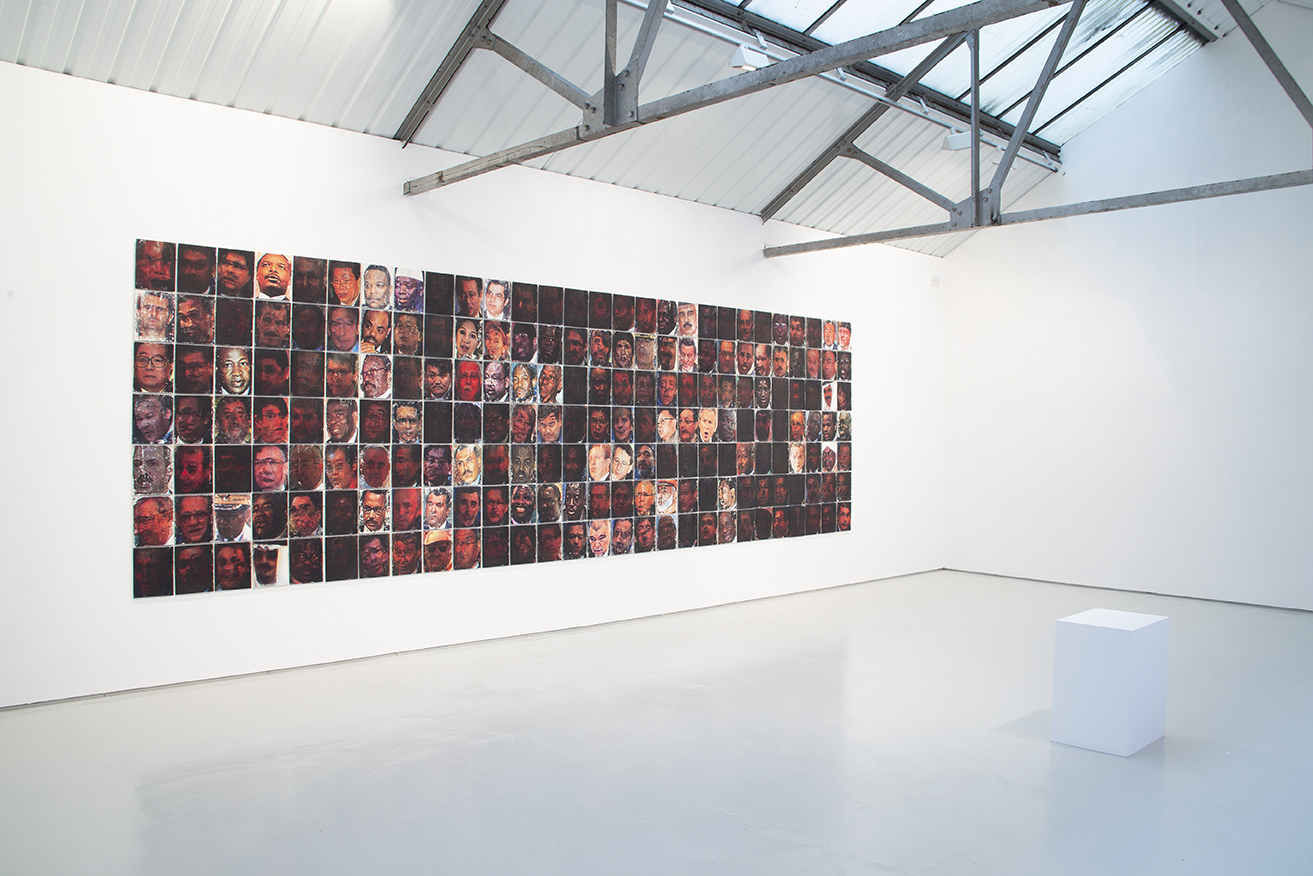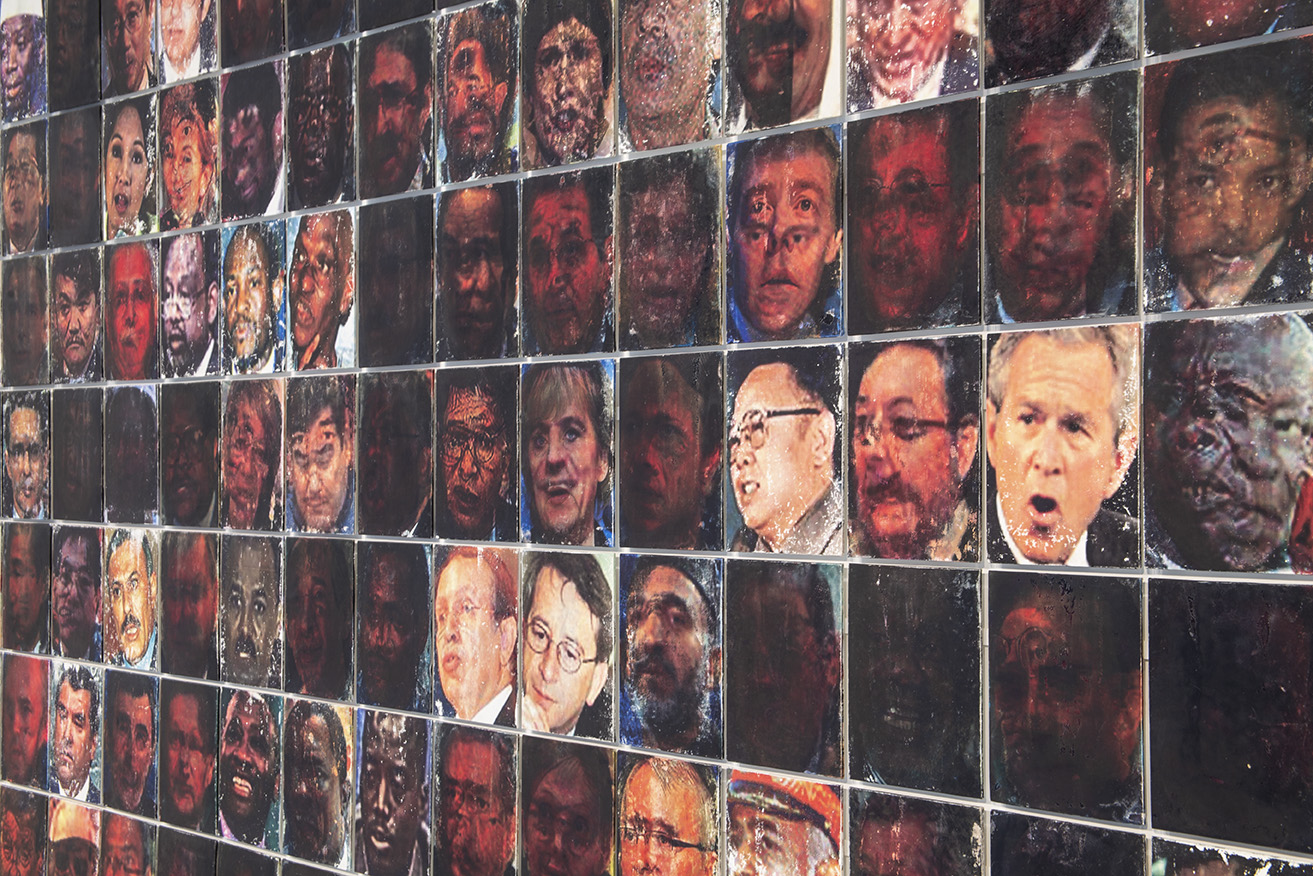
A pow-wow, according to the native North American tribes, is a meeting of great leaders, often associated with peace talks. Pow-wow is a portrait of all the world leaders, in mid speech, of all 196 nation states at the time of making. It spans the 8-year term of office of former president George W. Bush.
The work derives from my ongoing series at that time titled Modular Panels, which was a constantly expanding and contracting rhizomatic structure of identically sized media images, portraits, and iconography, and my indignation at both George Bush’s foreign policy, particularly around the environment and the Middle East, and the apparent complicity in all this of other nations of the world.
Presented as a visual palimpsest, each panel chronologically records the passage of power. As a new leader is voted out, ousted, or dies, their successor is added, with each new transfer layer gradually obscuring the ones beneath. The resulting image demonstrating the ephemerality of power, the human condition, and the parallels of popularity and authoritarianism, hinting at the tensions and political instability that underpin world events.
Pow-wow by Emma Cocker, 2006
Richard Bartle’s large-scale work Pow-wow emerges in the threshold space between fact and fantasy. It is somewhere between the poles of political reality and Utopian desire. On the one hand, the work functions objectively as a visual map that documents the shifts and fluctuations within the landscape of global politics. On the other, it speaks of an individual’s relentless attempt to organize and gather the world’s leaders together in one place that they might begin to talk and reach reconciliation.
Since 2001, Bartle has traced and documented the rise and fall of world leaders, laboriously reproducing their images on a series of small canvases through a process which reflects and measures the almost daily changes and disruptions in the political arena. Each canvas catalogues the recent political history of a specific state or republic and serves to capture each new leader’s ascent to power. Their subsequent political demise is then charted by erasing or burying them beneath the image of their successor. Political stasis is suggested in the more readable images. In others, the dense palimpsest of innumerable layers evokes a more volatile or unstable past.
The act of burial is an ambiguous ritual that is a marker of both protection and repression: it serves to erase or hide an object, individual or event from the past and locate it beyond the realm of the visible. Burial can be understood as a gesture of care, where the valuable or vulnerable are placed beyond the reach of harm. It might speak of a more willful concealment or deception at play, where certain facts or occurrences are deliberately hidden or corrupted so that they may never be brought to trial. Hidden within the cloudy recesses of both personal and political memory, located in unknown archives and in unnamed graves, or else concealed within coded and impenetrable pockets of the world wide web, the ghosts of unspoken and unspeakable histories still stir from under a fiction of normality. In different ways, both archaeology and psychology work to uncover these latent layers and historical fragments, drawing them to the surface that they may be forced to account for their role within the events of the present.

Pow-wow similarly attempts to document and make visible the latent power structures of global politics. In doing so, the political landscape is revealed as a mutable and ever changing topography, where it becomes impossible to ever achieve a fixed or coherent map of leadership. Paradoxically, the attempt to catalogue and record the political lineage of a place instead serves to bury or blur any possibility of recognition. Individuals perform their brief role on the world stage before disappearing into political obscurity, where they will no longer be held responsible for the trajectory of future actions or events.
Politically speaking then, the promise of responsibility and accountability serves the rhetoric and hyperbole of the speech podium but often falters or stalls in any practical sense. Bartle’s insistent search for and record of changes in political power is perhaps a relentlessly futile gesture. The desire to bring together the sprawling mass of political leadership in order to propose the possibility of discussion, or “Pow-wow”, collapses, as the terrain is never certain or stable and there are only ever a limited number of visible or identifiable individuals who could be petitioned and taken to trial. Bartle reveals a subtext of complex patterns and unexpected visual parallels, where there is an unlikely symmetry between the iconic presence of leaders in both dictatorships and popular democracies. It is a dark register of the transfer of power, both where the government is efficiently elected, or else anarchically absent and out of control.

20-21 Visual Arts Centre. Conflict. 2007
Like all Utopian dreams, Bartle’s Pow-wow is perhaps a figment of the imagination. Yet at the heart of all such delusional plans lies the irrepressible belief in the possibility of rewriting or re-conceptualizing reality as something “other” or as something different, a desire for a world beyond that of the present reality. Whilst the global discussion proposed by the work may never happen, the attempt to conjure it in a different form remains a marker of human hope and of necessary protest.
Powwow - movie
The Sheffield Pavilion
In 2009 Sheffield Contemporary Arts Forum commissioned a video work from the original Powwow assemblage, for inclusion in the 2009 Sheffield Pavilion project at the 11th Istanbul Biennial.
Screenings
11th Istanbul Biennial - 2009. Istanbul
Pan-demonium - 2009. AC Institute New York
Object Image led by Fatos Ustek - 2010. no.w.here. London
Copenhagen International Documentary Film Festival - 2010
Jihalava International Documentary Film Festival - 2010 Czech Republic
© Richard Bartle, all rights reserved.